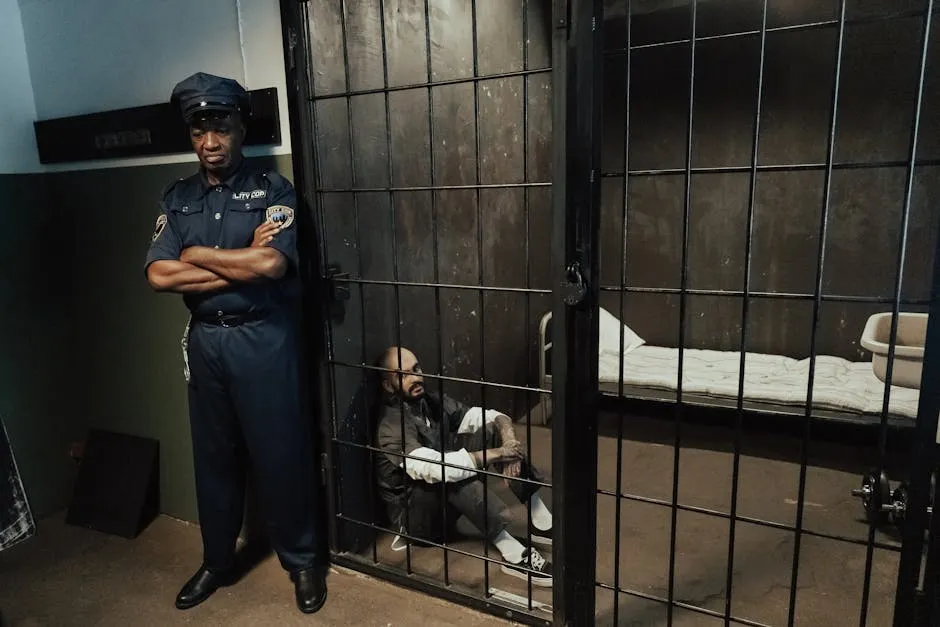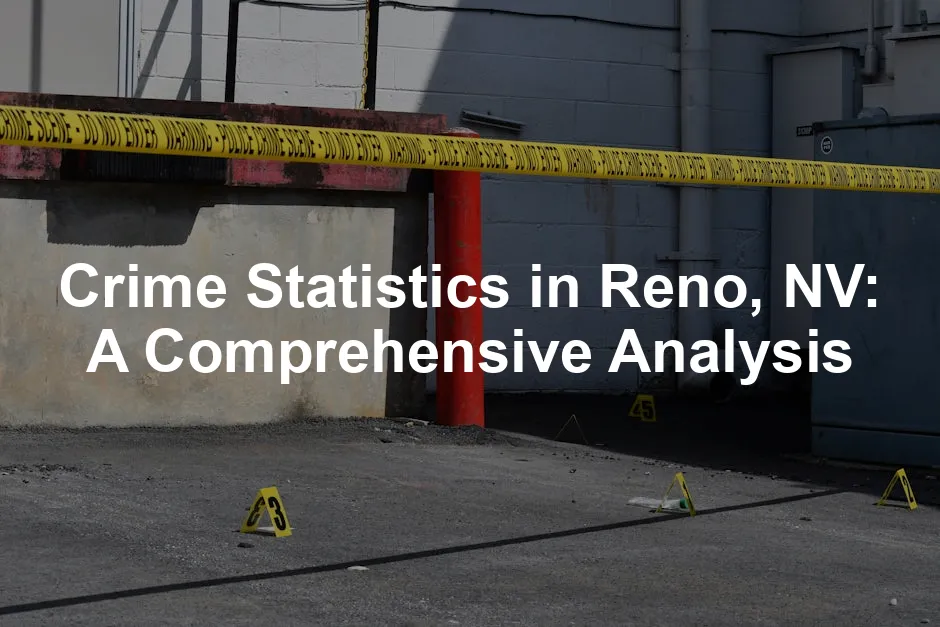Introduction
Reno, often dubbed the “Biggest Little City in the World,” is a vibrant urban area in Nevada. Known for its casinos, outdoor activities, and a growing population, Reno is an exciting place to live. However, as the city expands, so do its complexities, particularly concerning crime.
Understanding crime statistics is crucial for both current residents and those considering a move to Reno. Knowledge of local crime rates can provide insights into safety, community engagement, and even real estate decisions.
This article aims to dissect Reno’s crime landscape comprehensively. We’ll analyze crime rates over time, delve into specific types of crimes, explore neighborhood statistics, and compare these figures with national averages. By the end, you’ll have a clearer picture of what to expect in Reno regarding crime, ensuring you make informed decisions about living or investing in this dynamic city.
Understanding Reno’s Crime Landscape
Historical Context of Crime in Reno
Over the past two decades, Reno has experienced notable crime trends. The city’s population has seen a significant increase, which naturally correlates with fluctuations in crime rates. As Reno attracts new residents, it grapples with diverse socioeconomic factors that influence crime patterns.
In the early 2000s, Reno’s crime rates were relatively stable, but things shifted dramatically around 2010. Reports from the FBI show a rise in both violent and property crimes during this period. Factors such as economic downturns and increased drug-related issues contributed to this spike.
However, in recent years, there’s been a slight overall decrease in total crime rates. For instance, the city recorded a 5.2% decline in total crime year-over-year. Still, violent crime remains a significant concern, with rates 55% higher than the national average. This juxtaposition of declining property crime and rising violent crime raises questions about community safety and law enforcement effectiveness.
Reno’s unique characteristics, such as its transient population and tourism influx, also play a role in shaping its crime landscape. As the city continues to grow, understanding these historical trends is crucial for residents and local authorities alike.

Current Crime Rates
Total Crime Statistics
As of 2022, Reno’s total crime rate stands at an astonishing 8,559 incidents per 100,000 people. This figure is a stark reminder of the city’s challenges, as it represents a rate 35% higher than the national average. When compared with state averages, Reno’s crime statistics also paint a concerning picture, indicating a pressing need for safety measures and community engagement.
To put these numbers into perspective, let’s examine the breakdown of crime statistics. The violent crime rate in Reno is particularly alarming, with 1,565 incidents per 100,000 people. This rate dwarfs that of the national average, which hovers around 370 incidents per 100,000 people.
Property crimes, while slightly lower, are still significant. Reno experiences a property crime rate of 6,994 incidents per 100,000 people, which is also higher than the national average. This includes crimes such as burglary, theft, and vehicle theft, each contributing to the overall crime picture in the city.
Reno’s law enforcement agencies are actively working to address these issues, focusing on community outreach and crime prevention programs. However, the current statistics serve as a wake-up call for residents and city officials to prioritize safety initiatives. If you’re looking to enhance your home security, consider investing in a Home Security Camera System to keep an eye on your property and deter potential criminals.
Overall, understanding these current crime rates is essential for anyone living in or moving to Reno. It fosters a sense of awareness and encourages proactive measures to enhance community safety and security. For a deeper understanding of safety in the area, consider looking into the fremont crime statistics.

Understanding crime statistics is vital for making informed decisions about safety. Fremont crime statistics can provide valuable insights into safety trends.
Violent Crime Rates
Reno, NV, has earned a reputation for its vibrant nightlife and outdoor adventures. But, lurking beneath the surface is a troubling statistic: violent crimes are 55% higher than the national average. Yes, you read that correctly! In 2022, the city recorded a staggering 1,565 violent incidents for every 100,000 residents. This alarming number includes murder, rape, robbery, and assault, making Reno a notable outlier in terms of safety.
To break it down further, let’s take a closer look at the individual categories of violent crime.
- Murder: Reno recorded 11 homicides in 2022. While this figure seems modest, it still contributes to the growing concern about safety.
- Rape: With a rate of 101.2 incidents per 100,000 people, the number of reported rapes in Reno exceeds the national average of 40. This statistic is particularly alarming and underscores the need for community awareness and prevention efforts.
- Robbery: At 109.6 incidents per 100,000 residents, robbery rates are also significantly higher than the national average of 66.1. Victims of robbery often face traumatic experiences, making this a serious concern for the community.
- Assault: The assault rate stands at 357 incidents per 100,000 people, further fueling the narrative that Reno has a violent crime problem.
Several factors contribute to these elevated violent crime rates. Reno’s rapid population growth, primarily spurred by an influx of new residents seeking better job opportunities and a higher quality of life, plays a significant role. However, with a larger population comes increased competition for resources, potentially leading to heightened tensions and conflicts.
Moreover, Reno’s unique characteristics—like its proximity to major tourist attractions—can draw in individuals whose motives may not always align with community safety. The transient nature of the population, including tourists and seasonal workers, complicates the crime landscape.
Another contributing factor is the economic disparity observed in some neighborhoods. Areas with higher poverty rates often experience elevated crime rates. In Reno, the high cost of living, combined with insufficient wages in certain sectors, can lead to desperation and, consequently, crime.
Local authorities are aware of these trends and are actively working to implement community outreach programs and educational initiatives aimed at reducing violent crime. Regular community meetings and collaboration with local organizations aim to foster a sense of safety and shared responsibility among residents.
In summary, while Reno shines with its entertainment and outdoor opportunities, the harsh reality of its violent crime rates cannot be understated. Understanding these statistics is key for both current residents and those considering a move to the area. Awareness can lead to proactive measures, community engagement, and ultimately, a safer environment for everyone in the “Biggest Little City in the World.” Consider carrying a Personal Safety Alarm for added peace of mind when out and about!

Property Crime Rates
Reno’s charm isn’t just about its casinos and breathtaking vistas; it has a darker side, too. Property crime rates in Reno are 35% higher than the national average, with 6,994 incidents per 100,000 residents recorded in 2022. Now that’s a statistic that might make you think twice before leaving your car unlocked!
Let’s take a closer look at the categories of property crime that contribute to this alarming figure:
- Burglary: The burglary rate in Reno stands at 406.7 incidents per 100,000 people. This number is slightly below the state average but still illustrates a significant challenge for residents.
- Theft: With an astounding 1,750.3 thefts per 100,000 residents, this category is the most prevalent property crime in Reno. This includes everything from shoplifting to pickpocketing, showcasing a community in need of vigilance.
- Vehicle Theft: At 398.7 incidents per 100,000 residents, vehicle theft is a serious concern. It’s essential to be cautious and take preventative measures, like parking in well-lit areas or investing in a good alarm system. Consider a Car Alarm System to deter thieves!
When comparing these rates to national statistics, it becomes clear that Reno is struggling with property crime. The national average for property crimes hovers around 2,380 incidents per 100,000 people. Comparatively, Reno’s figures paint a concerning picture.
Several factors contribute to the high property crime rates. One critical element is the economic landscape. The cost of living in Reno is higher than the national average, which can lead to financial strain for many residents. As people face economic hardships, the temptation to engage in property crimes can increase.
Additionally, the transient population, including seasonal workers and tourists, can lead to fluctuations in crime rates. These individuals may not have the same investment in community safety as long-term residents, making them more likely to engage in criminal activities.
While the Reno Police Department works diligently to combat property crime through community policing and outreach programs, it’s crucial for residents to remain vigilant. Simple actions like locking doors, securing windows, and investing in Smart Door Locks can go a long way in reducing the likelihood of becoming a victim.
In conclusion, while Reno offers many exciting opportunities, the reality of its property crime rates serves as a reminder for residents to stay informed and proactive. Understanding the statistics and the factors contributing to these rates is vital for fostering a safer community and ensuring that the charm of Reno shines brightly for all.

Visual Representation of Crime Distribution
Reno’s crime landscape isn’t merely about numbers; it can be graphically represented! Crime maps offer a vivid visual of where crime hotspots are located within the city. These maps highlight areas where crimes occur more frequently, allowing residents and potential movers to understand which neighborhoods may warrant extra caution.
For instance, the downtown area, complete with its bustling nightlife and tourist attractions, often shows higher crime rates. A crime map reveals a striking pattern: the more foot traffic, the more potential for crime. This correlation is crucial. In areas where people gather—think bars, clubs, or popular parks—criminal activity can spike. The reasons? Increased opportunity and often, less surveillance.
However, it’s essential to understand that a high concentration of crime does not necessarily mean danger lurks at every corner. Some hotspots, while marked red on crime maps, might be influenced by the sheer volume of people. For example, you might see elevated crime stats near the airport or major tourist spots, but these figures are often inflated by transient populations.
Local law enforcement and community organizations have recognized this trend. They stress the importance of being aware of these crime distributions. Understanding where incidents occur can help residents stay vigilant. To further enhance your safety, consider investing in Outdoor Motion Sensor Lights to illuminate your property and deter potential intruders!
Moreover, neighborhoods known for their lower crime rates, such as South Reno or the North Valleys, shine on these maps. These areas showcase the beauty of community engagement and proactive safety measures. Residents in these neighborhoods often report feeling safe, contributing to a more positive living experience.
In conclusion, crime maps are more than just pretty pictures; they provide essential insights. They allow residents to navigate Reno safely and encourage them to engage in community programs aimed at enhancing neighborhood security. After all, knowledge is power, especially when it comes to ensuring your safety in the “Biggest Little City in the World.”

Factors Influencing Crime in Reno
Socioeconomic Factors
When it comes to crime, the economic climate plays a significant role. Reno’s cost of living has been on the rise. As housing prices soar, many residents feel the pinch. Unemployment rates also fluctuate, creating a perfect storm for crime. When people struggle financially, desperation can lead to an uptick in property crimes.
High costs can squeeze individuals and families, making basic necessities harder to afford. This pressure can lead some to resort to crime as a means of survival. In fact, studies show that economic stress is a common precursor to increased property crimes, such as burglary or theft.
Understanding these socioeconomic factors is crucial for tackling crime effectively. Local authorities recognize the link between economic hardship and criminal behavior. They are working on initiatives that provide job training, financial education, and housing assistance. These programs aim to reduce economic strain, which, in turn, may help decrease crime rates.
Additionally, the city’s rental market presents challenges. With average rental rates hovering around $1,107 per month, many residents are left scrambling. This high cost of living can push individuals into precarious situations, making crime a tempting option. For those looking for a bit of adventure, consider picking up an Outdoor Adventure Guidebook to explore the beautiful surroundings of Reno while staying safe!
There’s also the issue of income disparity within neighborhoods. Areas with significant income gaps often report higher crime rates. Neighborhoods with lower socioeconomic status frequently face higher incidences of crime, further perpetuating a cycle of poverty and criminal behavior.
Community leaders are increasingly focusing on these socioeconomic issues. By addressing the root causes of crime, they hope to foster a safer environment for everyone. Initiatives aimed at economic development can lead to lasting change.
In summary, the socioeconomic landscape in Reno directly influences crime rates. Recognizing this connection empowers the community to advocate for programs that can alleviate financial stress and, ultimately, reduce crime. After all, a thriving economy benefits everyone, making Reno not just a great place to visit, but also a safer place to live.

Community and Law Enforcement Response
Crime rates can tell a story, but community response often writes the ending. In Reno, the police department plays a pivotal role in shaping safety. The Reno Police Department (RPD) is committed to not just enforcing the law but also building trust within the community.
Community policing is a cornerstone of their strategy. This proactive approach fosters positive relationships between officers and residents. By engaging with the community, officers can identify issues before they escalate. Regular neighborhood meetings, safety workshops, and outreach programs help bridge the gap.
Moreover, community programs specifically designed to reduce crime have been implemented. For instance, neighborhood watch groups empower residents to look out for one another. These initiatives cultivate a sense of responsibility and vigilance, making neighborhoods safer. You might also consider a Neighborhood Watch Sign to promote awareness in your area!
But it’s not just about law enforcement. Local organizations and nonprofits also contribute. They provide resources to at-risk youth, offering mentorship and educational opportunities. By investing in the community, they tackle the issues that often lead to crime.
In recent years, the RPD has also embraced technology. Crime mapping and data analysis help allocate resources effectively. This means officers can focus on high-crime areas, optimizing their presence where it’s needed most.
In conclusion, the collaboration between law enforcement and the community is vital. Together, they create a safer Reno. The proactive measures taken by the RPD, combined with community engagement, build trust and pave the way for a brighter future. After all, safety is a shared responsibility, and when a community comes together, everyone benefits.

Year-over-Year Trends
Recent Trends in Crime Rates
Reno’s crime statistics have experienced some intriguing shifts recently. In a year-over-year comparison, total crime has decreased by 5.2%. This sounds like a victory dance for the safety-conscious, right? Well, hold onto your hats! While total crime is down, violent crime has taken a bit of a leap, increasing by 3.4%. It’s like a seesaw—one side goes down while the other goes up!
Let’s break this down further. The total crime rate stands at a substantial 8,559 incidents per 100,000 people. With this figure, Reno finds itself 35% above the national average. Yikes! To stay on top of your safety game, consider equipping yourself with a Pepper Spray for self-defense!
Now, focusing on the brighter side, property crime has seen a decrease of 6.9%. This includes categories like burglary and theft, which are vital when it comes to community safety. Yet, the rising violent crime rate is a cause for concern.
What does this mean for residents? It signifies a need for vigilance. With crime rates fluctuating, it’s essential to stay informed. For example, residents should consider joining neighborhood watch programs or engaging in local community events focused on safety.
Statistics reveal that violent crime includes serious offenses like murder, rape, robbery, and assault. In 2022, Reno reported 1,565 violent incidents per 100,000 people. That’s a stark comparison to the national average of around 370. It’s almost like Reno is playing a game of “who can make the most noise?” but with crime stats instead!
This juxtaposition of declining property crime and escalating violent crime raises eyebrows. What’s going on? Is it the population growth? The influx of newcomers? Or perhaps the economic stressors that often accompany a growing city?
The community must be proactive. Local law enforcement is making strides to address these concerns, but everyone has a role to play. Whether it’s attending community meetings, staying alert, or sharing safety tips, every little bit helps in fostering a safer environment.
In summary, while we can celebrate a slight dip in total crime, the increase in violent crime calls for a collective effort. Reno residents need to stay engaged and informed to navigate this evolving landscape effectively.

Future Projections
Looking ahead, what can we expect from Reno’s crime scene? Projected crime rates seem cautiously optimistic. With the current trends suggesting a decrease in total crime, there’s hope for continued improvement. However, the persistent rise in violent crime raises a red flag that can’t be ignored.
Local policies will play a crucial role in shaping these projections. Initiatives aimed at economic stability, job creation, and community engagement could significantly impact crime rates. For instance, if local authorities enhance community policing efforts, there may be a reduction in violent crimes.
Furthermore, it’s essential to consider the socioeconomic factors at play. With the high cost of living in Reno, many residents face economic challenges. Addressing these issues through community programs and outreach can lead to lower crime rates in the long run.
Experts suggest that by fostering a collaborative environment between law enforcement and residents, the community can effectively tackle crime. Programs that promote youth engagement, education, and job training can help steer individuals away from criminal activities. For those looking to enhance their home security further, investing in a Emergency Survival Kit can provide peace of mind in uncertain times.
In conclusion, while the future appears to hold some promise for Reno’s crime rates, the community must remain vigilant and proactive. By supporting local policies and engaging with one another, residents can contribute to a safer, more vibrant Reno. After all, safety is a shared responsibility, and together, we can make a difference!

Conclusion
In summary, Reno’s crime statistics present a mixed bag. While total crime has decreased by 5.2%, violent crime has crept upwards by 3.4%. This contrast highlights the city’s ongoing challenges and the need for continued vigilance.
Understanding these trends is vital for residents. Awareness can lead to proactive measures that enhance community safety. Residents should engage with local law enforcement, attend community meetings, and support safety initiatives. Consider keeping a First Aid Kit handy for emergencies!
Ultimately, crime statistics tell a story that affects everyone. By staying informed and actively participating in community safety efforts, residents can help foster a safer environment for all. Together, we can transform Reno into a community where safety thrives and everyone feels secure.
FAQs
What are the safest neighborhoods in Reno?
Reno boasts several neighborhoods where safety reigns supreme. If you’re seeking peace of mind, consider the following areas: North Valleys, South Reno, Northwest Reno. While these neighborhoods shine bright, it’s always wise to stay alert and informed. Even in safe areas, being proactive about personal safety can help maintain that peace of mind.
How does Reno’s crime rate compare to other cities in Nevada?
Reno’s crime rate puts it in an interesting spot within Nevada. While Reno is a bustling urban center, its crime rates are notably higher than many smaller nearby cities. For example, Sparks has a violent crime rate of approximately 417 incidents per 100,000 people, Carson City has a total crime rate lower than Reno’s. In summary, Reno’s crime rates are about 35% higher than the national average, which means it’s crucial for residents and visitors to stay aware of their surroundings.
What steps can residents take to enhance their safety?
Enhancing personal safety in Reno involves a mix of vigilance and community involvement. Here are some quick tips: Stay Informed, Engage with Neighbors, Secure Your Property, Utilize Resources. Remember, safety is a community effort. By working together and staying proactive, residents can cultivate a safer environment for all.
How often are crime statistics updated?
Crime statistics are updated regularly to keep the public informed. In Reno, the FBI releases annual crime reports based on data collected from law enforcement agencies. This includes updates on violent and property crimes, ensuring that residents have access to the latest statistics. In addition to FBI reports, local agencies like the Reno Police Department also update crime data frequently, often on a quarterly basis.
Please let us know what you think about our content by leaving a comment down below!
Thank you for reading till here 🙂
All images from Pexels




